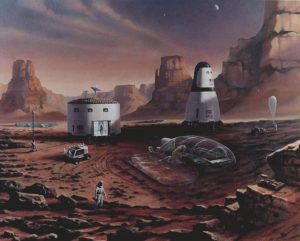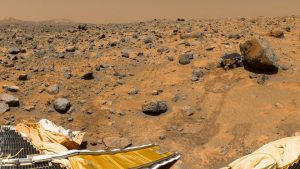I first thought about the lone colonist of Mars by the chance association between two very different and, some would say, antithetical ideas. I designed a university course on the changing perception of Mars in literature over the past two centuries at nearly the same time as active projects to take people to Mars were finding their footing. As well, I realized when I was looking through the information on the planet online, that some deluded people thought the planet was already inhabited, although they could not explain their reasoning at all cogently.
In preparation for the course, I read  about Robert Zubrin’s Mars Direct plan, which seeks to place humans on the surface of the planet within a few years, and the more recent Mars One team’s scheme to televise the adventures of the colonists they claim will be in place in 2025. I was especially interested in the Mars One’s idea of one-way colonization. This makes much more scientific sense than Mars Society’s bypass venture whose only purpose is to grab some rocks and return, although it is also much more challenging in terms of engineering and human resourcefulness. While looking through the photos from the Mars rovers, I began to understand that
about Robert Zubrin’s Mars Direct plan, which seeks to place humans on the surface of the planet within a few years, and the more recent Mars One team’s scheme to televise the adventures of the colonists they claim will be in place in 2025. I was especially interested in the Mars One’s idea of one-way colonization. This makes much more scientific sense than Mars Society’s bypass venture whose only purpose is to grab some rocks and return, although it is also much more challenging in terms of engineering and human resourcefulness. While looking through the photos from the Mars rovers, I began to understand that  while I was excited about recent scientific advances, there were others online who were both distrustful of authority and extremely gullible.
while I was excited about recent scientific advances, there were others online who were both distrustful of authority and extremely gullible.
One of the most profound examples of this paranoid naiveté are the people who pore over the latest NASA rover images looking for evidence of life. NASA is accustomed to people like the flat-Earthers claiming that their photographic evidence is manufactured and that their findings about the burgeoning carbon dioxide in Earth’s atmosphere are  false. But more recently, as they post their pictures, there are people who expand the view in order to find what NASA has missed. Some of these people are determined to both prove NASA wrong and to be the first people to discover life on Mars. Accordingly, they scour the pictures of the surface looking for geological anomalies, familiar shapes, and more significantly, living beings.
false. But more recently, as they post their pictures, there are people who expand the view in order to find what NASA has missed. Some of these people are determined to both prove NASA wrong and to be the first people to discover life on Mars. Accordingly, they scour the pictures of the surface looking for geological anomalies, familiar shapes, and more significantly, living beings.
These armchair investigators’  use of pictures leads them to cite hard-to-interpret bulges in the landscape or angular rocks which resemble familiar shapes as evidence. When they are asked for something more substantial, they immediately reply with conjecture, cut-and-paste from Wikipedia, and
use of pictures leads them to cite hard-to-interpret bulges in the landscape or angular rocks which resemble familiar shapes as evidence. When they are asked for something more substantial, they immediately reply with conjecture, cut-and-paste from Wikipedia, and  pixelated photos. They argue for the significance of dozens of photographic anomalies, arguably the most famous of which is probably the hill on Mars which they claimed resembled a human face.
pixelated photos. They argue for the significance of dozens of photographic anomalies, arguably the most famous of which is probably the hill on Mars which they claimed resembled a human face.
My reader may remember the Face on Mars controversy that so bruised the public attention that even NASA felt compelled—to counter claims of a cover-up—to change the orbit of one of their craft for a second look. Their audience showed so much more interest in the face than they ever had NASA’s legitimate science, that when public statements advised it was merely an artifact of the light and play of shadow, the gullible public accused NASA of hiding the truth. For the armchair investigators on Earth, this was proof positive that Mars is or had been inhabited, although they offered little explanation for the family resemblance between Martians and humans.
change the orbit of one of their craft for a second look. Their audience showed so much more interest in the face than they ever had NASA’s legitimate science, that when public statements advised it was merely an artifact of the light and play of shadow, the gullible public accused NASA of hiding the truth. For the armchair investigators on Earth, this was proof positive that Mars is or had been inhabited, although they offered little explanation for the family resemblance between Martians and humans.
Another famous image that has diverted attention from real science is that of a curiously-shaped rock outcropping that looks like a human figure.  For the “investigators,” it can be taken to be evidence of “a woman waiting for a bus on Mars.” Although some people come to laugh on the Reddit pages where such debates find a fertile ground of poor education coupled with profound ignorance, there are so many who take the picture seriously that the joke falls flat.
For the “investigators,” it can be taken to be evidence of “a woman waiting for a bus on Mars.” Although some people come to laugh on the Reddit pages where such debates find a fertile ground of poor education coupled with profound ignorance, there are so many who take the picture seriously that the joke falls flat.
I was entranced by the bland naiveté of the comments below articles where good-intentioned people would undermine such conjecture by reference to the woman’s relative size. They pointed to other photos from different angles—for a similar analysis was the undoing of the Face on Mars. One person with more of a science background vainly tried to explain that the woman could not exist because Mars possesses one percent of Earth’s air pressure. They were attacked by others who claimed the people could be using suits, like scuba gear, and still others sailed further offshore with their argument that their god could have given them an atmosphere or had them live without it. In the face of such blind assurance, scientific verifiability is as helpless as a fish on the shore, but there are lungfish. Like those tidal creatures, I began to wonder if I might be able to get some use out of conspiracy crowd’s profound ignorance.
Once I realized that these people who were arguing back and forth about the possibilities on the basis of such slim evidence were not merely trolling, I decided to place a colonist on Mars. In the absence of living beings on Mars, and in an internet environment which included so much blind faith, I decided to pretend that my colonist was sending regular reports from the surface. I used the latest pictures from the Opportunity and Spirit rovers, as well as what is known about the planet, and invented the difficulties that surrounded his attempt to survive such a harsh environment. He was never meant to be a spokesperson for Earthly environmental concerns, or to make pithy statements about managing the resources on a planet that the readers might take to heart. He was merely verbal flypaper, using thin watery honey to attract the flies who are drawn to nonsense.
Opportunity and Spirit rovers, as well as what is known about the planet, and invented the difficulties that surrounded his attempt to survive such a harsh environment. He was never meant to be a spokesperson for Earthly environmental concerns, or to make pithy statements about managing the resources on a planet that the readers might take to heart. He was merely verbal flypaper, using thin watery honey to attract the flies who are drawn to nonsense.
I set him up on BlogSpot, gave him a name, and watched as he dutifully wrote his daily, and by times weekly, blog entry from the red planet. Unfortunately, for my experiment, few were drawn to my bald-faced tomfoolery, and no one stepped forward to claim that NASA was lying about a colonist while a simple google search proved his existence. I collected a few serious followers who were perhaps excited by the creative project, such as a NASA scientist who specialized in ionization in the upper atmosphere, but in those early days of Mars online, my struggling colonist attracted little attention.
Perhaps because I was spending so much time making sure my colonist was encountering a real Martian environment and designing a course about how Mars has been written, I began to think more about the red planet. Within a year I was working on a novel about fifteen colonists and before long I turned back to the original inspiration and found my lone colonist’s story compelling in its own right. Perhaps because I was intent on making it appear both evocative and scientifically accurate, I had to imagine the life of a person millions of kilometres from Earth who was living with the knowledge that their food was running out and that rescue was not a possibility.
colonist’s story compelling in its own right. Perhaps because I was intent on making it appear both evocative and scientifically accurate, I had to imagine the life of a person millions of kilometres from Earth who was living with the knowledge that their food was running out and that rescue was not a possibility.
The ignorance of humanity, combined with our willingness to seek out knowledge, continues to be an inspiration to me. Although the first colonist on Mars is still to come—at least outside the pages of this book—it is a testament to the various space agencies around the world that we know as much as we do about Mars, and it is a testament to our own intransigence that we know so little.
